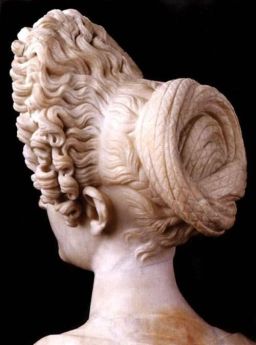
Nothing we have heard so far about royal women would lead us to believe that they were especially religious. In fact, they are not mentioned in that regard at all. And it is still up to debate how and in what manner women participated in the Jewish religion in the past. There were many rules women were to follow and sacrifices they were to make and a court in the Temple was called the Women’s Court so they could perform their duties and not contaminate the others. But perhaps a clue can be found that might indicate a woman’s degree of religion…by hints like this…this quote is from the mother of five high priest about her hair:
The hair was regarded by the Rabbis as so powerful an augmentation of beauty that married women were recommended to hide it…(T)he Talmud relates the following: Ḳimhit, the mother of seven sons who successively held the office of high priest, was once asked by what merit of hers she was so blessed in her sons. “Because,” said she, “the beams of my house have never seen my hair” (Yoma 47a). www.jewishencyclopedia.com

Perfection for a woman was to keep her hair covered by some kind of mantle perhaps. But royal Jewish women, in particular, copied Roman women to some extent and kept their hair braided and uncovered with any manner of curls in front and even a ringlet or two trailing down. There are several statues of Queen Bernice daughter of Agrippa I in Roman museums. They all show her with her hair firmly braided and uncovered….
So we can add royal women to list of those allowed to wear their heads uncovered, virgins, new brides, prostitutes, and royal women.
Bernice’s Hair
 But then Josephus relates a story about Bernice and her hair that changes the picture yet again. It takes place after the death of James in ca 62 CE. Tensions in Jerusalem grew ever more tense. Roman soldiers in the city began to kill citizens at random. Bernice tried to reach Florus the Procurator (ca 65 A.D.) to beg “him to leave off these slaughters.”
But then Josephus relates a story about Bernice and her hair that changes the picture yet again. It takes place after the death of James in ca 62 CE. Tensions in Jerusalem grew ever more tense. Roman soldiers in the city began to kill citizens at random. Bernice tried to reach Florus the Procurator (ca 65 A.D.) to beg “him to leave off these slaughters.”
Now she dwelt then at Jerusalem in order to perform a vow which she had made to God; for it is usual with those that had been either afflicted with a distemper, or with any other distresses, to make vows; and for thirty days before they are to offer their sacrifices, to abstain from wine, and to shave the hair of their head. Which things Bernice was now performing, and stood barefoot before Florus’s tribunal, and besought him [to spare the Jews]. Yet could she neither have reverence paid to her, nor could she escape without some danger of being slain herself… Wars of the Jews II.XV.1
“Wanton” “criminal” Bernice had taken a Nazarite vow! In another edition of The Jewish War, editor and translator Gaayla Cornfeld has a footnote about Bernice. He says that she was following “the custom of women Nazirites” and added this:
“Women Nazirites were mentioned on tombstones in Palestine and it is said that they wore veils, “two of which were prepared by 82 maidens.”
Could there have been seven veils for Nazarite women? (“Two of which…”) Or at least for Hasmonean women…the much-used royal “seven” veils? This, of course, brings to mind Salome and her “dance of the seven veils.” Mark simply says that Salome “danced” before Herod Antipas, but the passage also says that Salome was barefoot wearing seven veils to petition the king. Bernice, her first cousin, went before Florus barefoot and, it seems likely, with veils to cover the shorn hair of a short-term vow. Bernice did not just petition Florus as a queen, she took a Nazarite vow. One can see the event as being like Queen Esther asked her people to fast and pray for her before she took her life in her hands to go before the king of Persia to try and save her people.
Queen Helena
Queen Helene was from a small Arabian nation on the fringes of the Parthian empire whose capital was Arbela, present day Arbil in Iraq. Josephus allots a good deal of space to her and her special son. Here is a condensed version:
About this time it was that, the queen of Adiabene, and her son Izates…embraced the Jewish customs, and this on the occasion following: Monobazus, the king of Adiabene…fell in love with his sister Helena, and took her to be his wife, and begat her with child. But as he was in bed with her one night, he laid his hand upon his wife’s belly, and fell asleep, and seemed to hear a voice, which bade him take his hand off his wife’s belly, and not to hurt the infant that was therein…This voice put him into disorder…and when his son was born, he called him Izates. He had indeed, Monobazus, his elder brother, by Helena also, as he had other sons by other wives besides. Yet did he openly place all his affections on this his only begotten son Izates…Antiquities XX.II.
(Remember that Bernice and Agrippa were brother and sister ruling as king and queen and also accused of having “criminal conversation.”) As Josephus continues, Helena made a pilgrimage to Jerusalem in about 46-57 A.D. where she helped to purchase grain due to the draught mentioned in Acts and built herself a palace in Jerusalem. Dates are somewhat confusing, but Agrippa II was officially made king in 53, and Helena died in ca 50-56 A.D. Bernice and Helena would have known each other…and Helena made a Nazarite vow that spanned a third her adult life. The story comes from Rabbinic literature:
The strictness with which [Queen Helene] observed the Jewish law is thus instanced in the Talmud: “Her son having gone to war, Helena made a vow that if he should return safe, she would become a Nazarite for the space of seven years. She fulfilled her vow, and at the end of seven years went to Palestine. The Hillelites told her that she must observe her vow anew, and she therefore lived as a Nazarite for seven more years. At the end of the second seven years she became impure, and she had to repeat her Nazariteship, thus being a Nazarite for twenty-one years. R. Judah said she was a Nazarite for fourteen years only.” (Nazir 19b).
Bernice and Helena, both queens, made Nazarite vows…one long and one short. And it was even possible that Salome daughter of Herodias made a short-term Nazarite vow that was parodied or veiled by the gospel writers. Could we be seeing in the women’s stories a tradition of certain royal women trying to live by the laws of their religion and trying to help their people? Even Drusilla, faced with awful marital choices being imposed on her, took destiny into her own hands when she chose to marry an uncircumcised Roman procurator—was she just another “wanton” royal woman…or, perhaps did she do it so she would be in a position to act as an intercessor for her people…as Queen Esther did. It was the role of princesses to make political marriage alliance with the nation’s allies but also with their enemies. (Remember the story of Tharbis the Ethiopian I began with.) And it was clear that Palestine and Jerusalem were headed towards all-out war.
Josephus, male chauvinist that he was, couldn’t help but add the comment on Bernice’s risky intercession with Florus, that Nazarite vows could be made by those “afflicted with distemper,” bringing to mind Mary Magdalene and the women with her needing to be “healed of evil spirits and infirmities and seven devils.” (Luke 8:2) It was a patriarchal society, after all…
You might like my book ‘Jesus, King of Edessa’ – 600 pages of evidence for the historical Jesus.
It proposes that Queen Helena was Jesus’ mother. It was the sons of Queen Helena who fought the Jewish Revolt, and one of those sons was called King Izas Manu VI of Judaea and Edessa (the biblical King Jesus Em Manuel of Judaea).
And of course both of these kings were crucified by the Romans while wearing a Crown of Thorns (the traditional ceremonial crown of Edessa).
Ralph
LikeLike
Yes, and Izates was called “only begotten”, right? I’m sure you have other sources. I see that Josephus says that King Izates’s “sons and brothers…begged Caesar to grant them a pledge of protection”….He kept them all in custody temporarily and later sent the king’s sons and kinsmen in chains to Rome as hostages…VI.VI.III. I find the Queen fascinating. Will check out your book.
LikeLike
Hi!
So did I undestand right that if women takes nazarite vow she will still have to cover her hair?
Or would she let it loose?
Thank you!
LikeLike
That is the question…no one seems to know for sure. Since Josephus and the Roman procurator held Bernice in a sort of contempt for taking the vow, and since Mary Magdalene received a bad reputation for something…and as the mother of 5 high priest said, they were made high priests because the “beams of her house” had never seen her hair”, the extreme pious end of the scale…I thought it possible that Mary/Mariamne took a Nazarite vow as did Queen Bernice and Queen Helena and their right wing denigrated them for it…because they wore their hair loose…making them easy prey for a “fallen woman” label. Or at least, to not take them seriously in a very strict hierarchical world where women, even with royal blood, could easily be pigeon-holed and sidelined. It does say in the quote, though, that Nazarites had to shave their heads at the end of their vow and that Bernice was following the rules…so loose hair during the time of the vow, shorn head when performing the vow…either way, not easily understood and easy to deride.
LikeLike
Thank you for responding so quikly. Indeed its a though question. I my self am a christian women and I took the Nazarite vow on may this year and now I keep thinking should or should I not cover my hair…
LikeLiked by 1 person